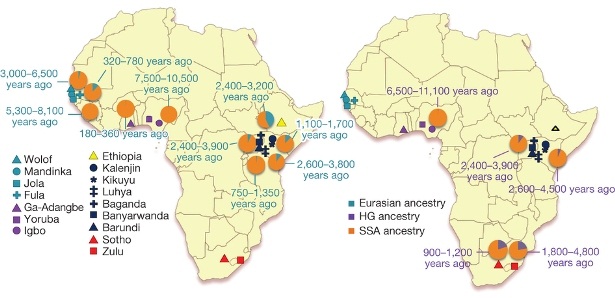
Scientists have made the most comprehensive map yet of African genetic variation and say it should help them learn more about the role genes play in diseases such as malaria, haemorrhagic fever and hypertension in populations there.
Publishing the findings in the journal Nature on Wednesday, Deepti Gurdasani of Britain's Wellcome Trust Sanger Institute, said that despite Africa being the world's most genetically diverse region, relatively little is known about potential genetic risks for disease among its populations.
In the United States, Europe and Asia, ever faster gene sequencing tools mean scientists have begun to untangle the genetic roots of many major diseases and explore their links to environment and lifestyle factors like diet, smoking and exercise.
"Infectious and non-infectious diseases are highly prevalent in Africa and the risk factors for these diseases may be very different from those in European populations," Gurdasani said.
The scientists - working in partnerships with doctors and researchers in Ethiopia, the Gambia, Ghana, Kenya, Nigeria, South Africa and Uganda - collected genetic data from more than 1,800 people to make a detailed map of 18 so-called ethnolinguistic groups in Sub-Saharan Africa.
The data also included 320 whole genome sequences from seven populations.
Dating and proportion of Eurasian and HG admixture among African populations (Figure 2 from the article The African Genome Variation Project shapes medical genetics in Africa, published in Nature, July 2014).
The team found 30 million genetic variants in the seven sequenced populations, a quarter of which they said had never previously been identified in any human population.
They also found clues about possible genetic regions being linked to increased susceptibility to high blood pressure and various infectious diseases including malaria, Lassa fever and trypanosomiasis, all common diseases in some parts of Africa.
"These genetic variants seem to occur with different frequencies in disease endemic and non-endemic regions, suggesting that this may have occurred in response to the different environments these populations have been exposed to over time," the scientists wrote.
The study, part of the African Genome Variation Project, also gives clues about the movement of ancient human populations - supporting a hypothesis that European and Middle Eastern populations migrated back to Africa around 9,000 years ago.
Read more:
Diverse ageing rates puzzle scientists
Individual genetic differences may affect Ebola survival
Scientists unravel the genetics of human height
Image: Syringe on map of Africa from Shutterstock




 Publications
Publications
 Partners
Partners










